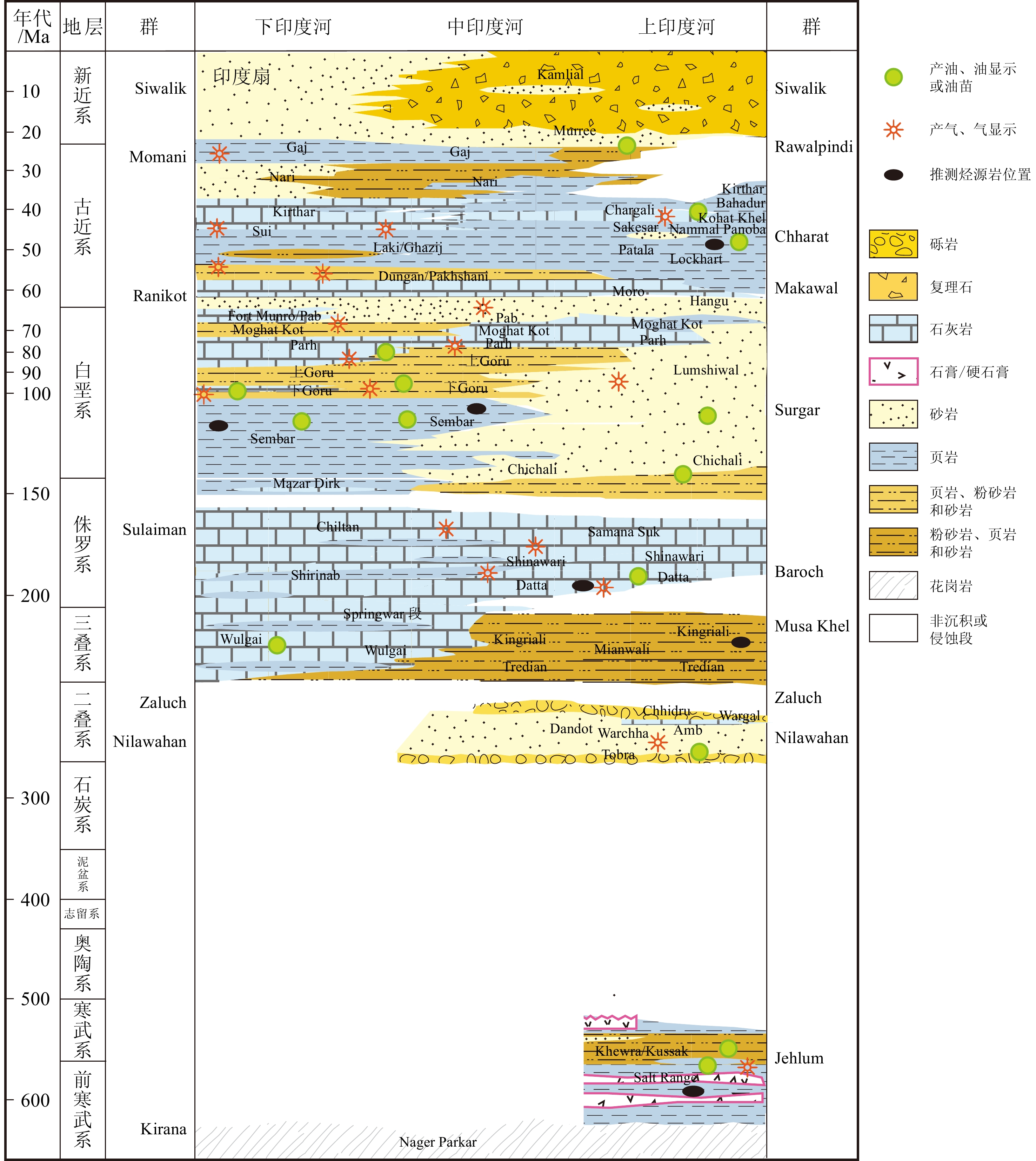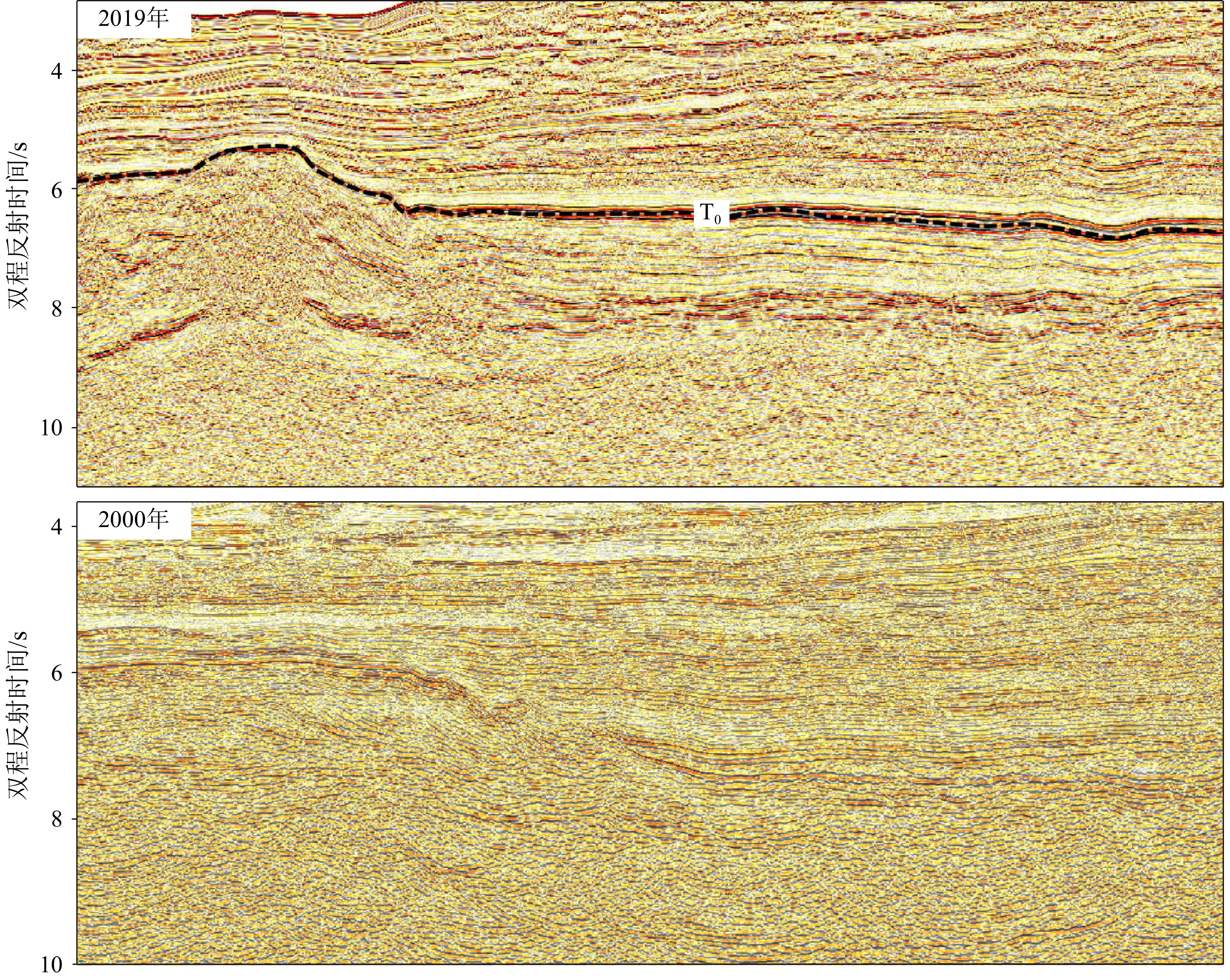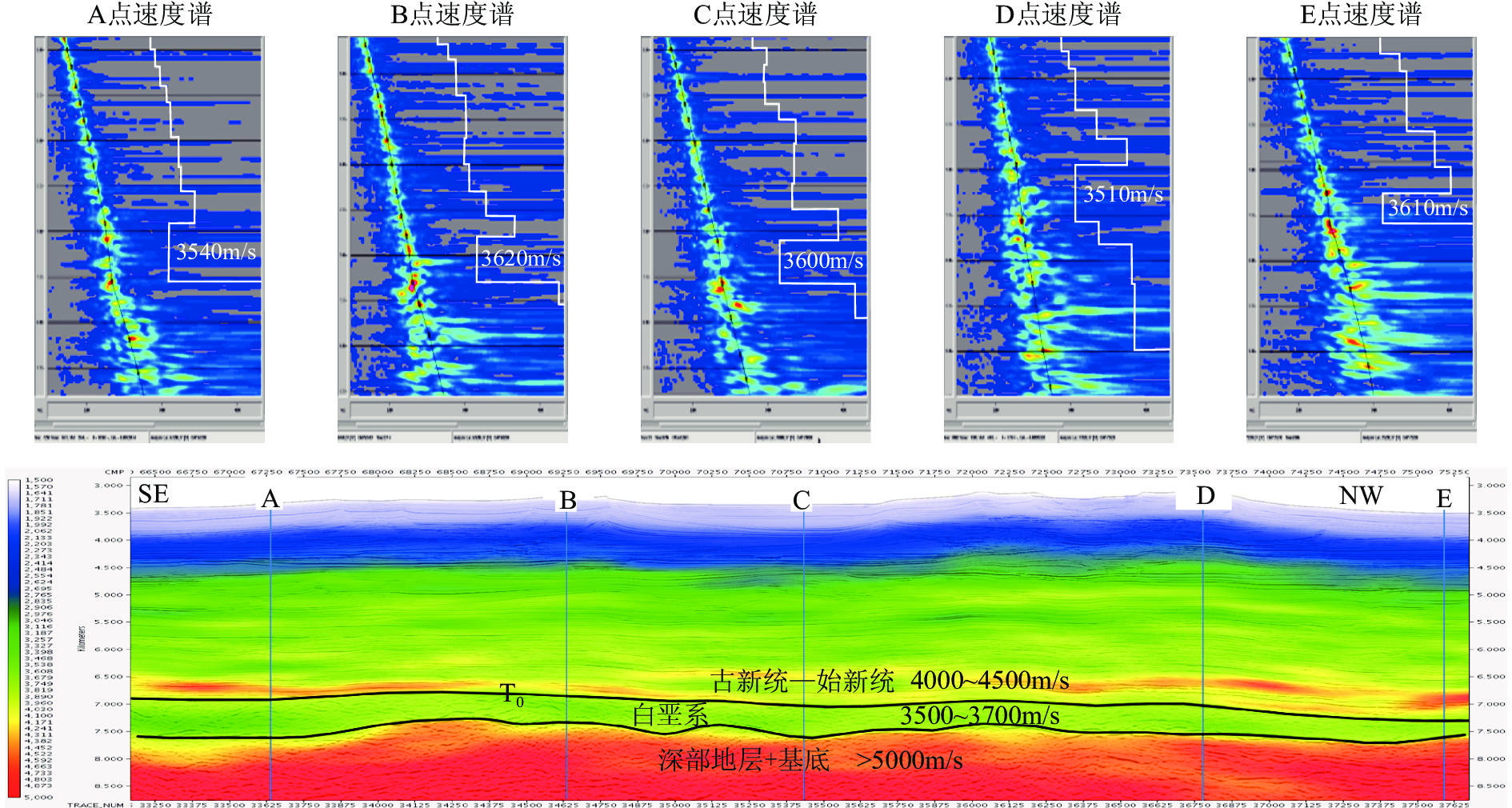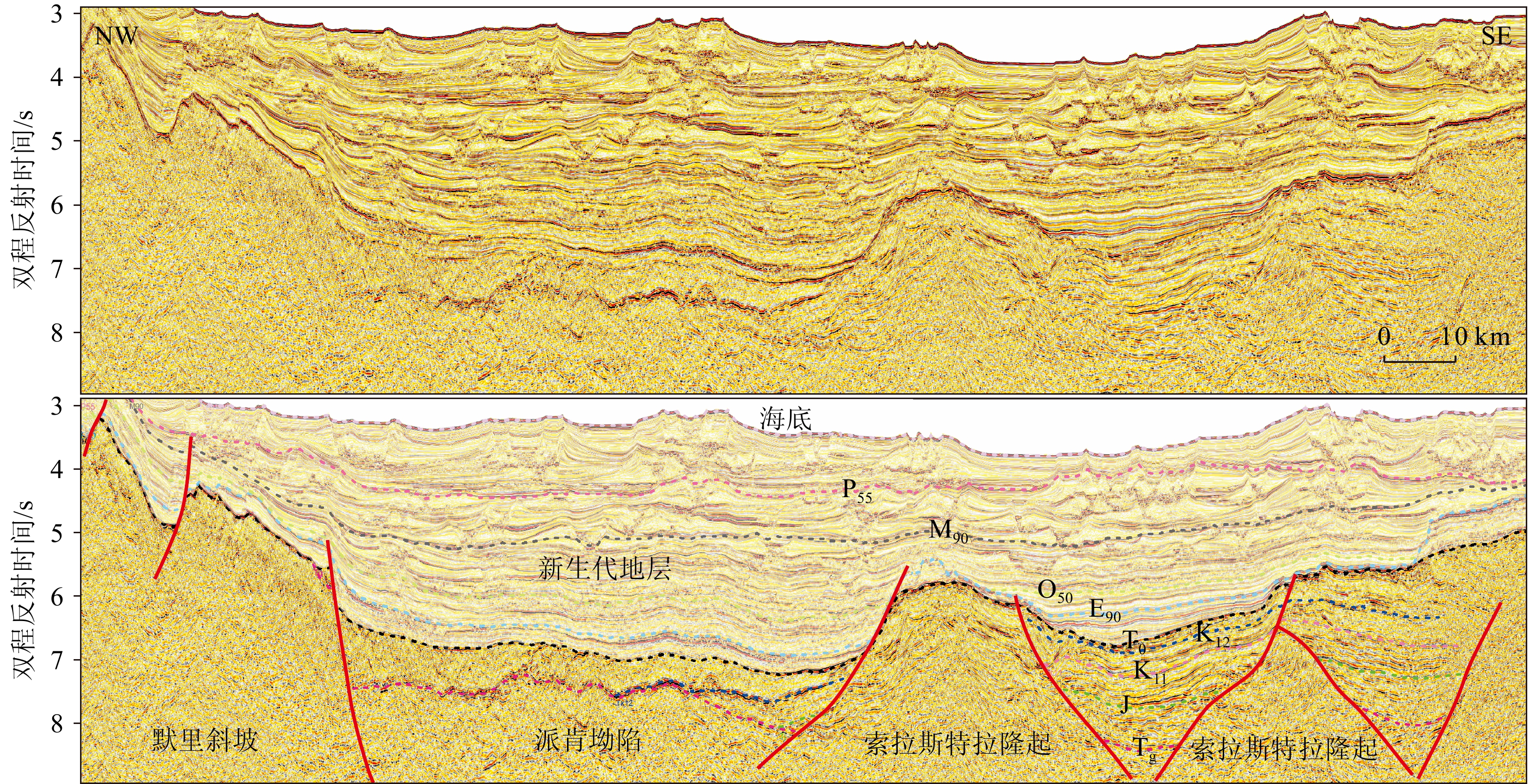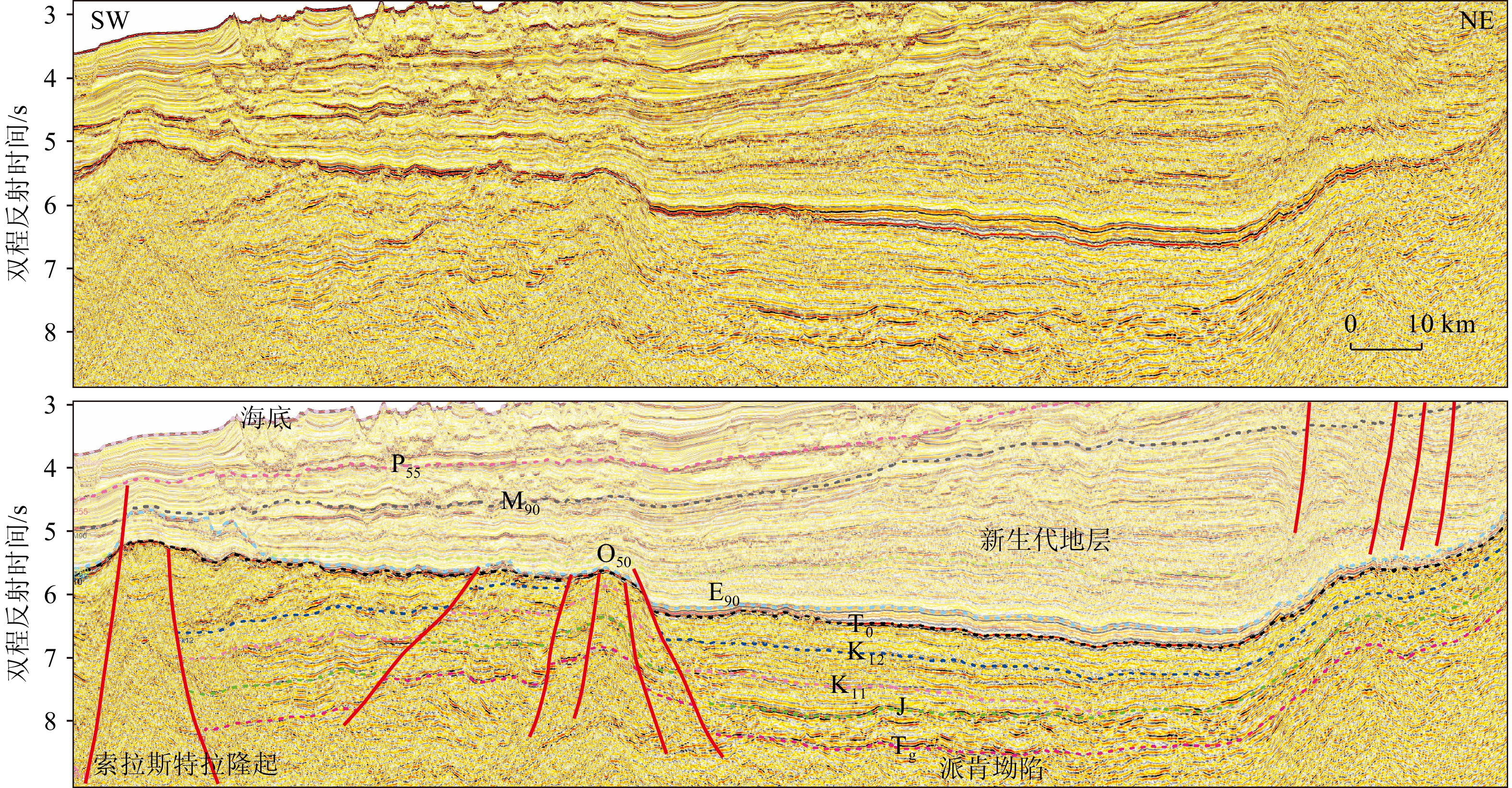Discovery of Mesozoic strata in the eastern region of offshore Pakistan and its oil and gas significance
-
摘要:
巴基斯坦海域历经60余年油气勘探,长期以新生界为主要目标,对中生代地层展布、构造演化特征等认识不清。巴基斯坦东部海域中—新生代时期经历了复杂的构造—沉积演化过程,新生代受喜马拉雅隆升影响而沉积了巨量陆缘碎屑物质,因此是研究诸多重大基础科学问题的极佳场所。受白垩纪晚期区域火成岩影响,对该区中生代地层是否存在、如何展布等问题一直存在较大争议,这极大限制了区域油气勘探活动的开展。本研究基于新采集的高品质二维地震剖面,突破了火成岩层的屏蔽作用,通过地震反射界面刻画、地震波组特征分析和层速度分析等手段,揭示了中生代地层在巴基斯坦东部海域广泛分布,中生代地层受控于同期活动的强烈伸展断陷作用,被隆坳相间的构造古地理格局分割在多个规模不等的次级凹陷内部。整体厚度800~10000 m,表现为东南厚、西北薄,向北和向西超覆,最大沉积厚度位于研究区东南和西北两个区域,该套地层在陆域下印度河盆地已证实为重要烃源岩层,因此海域中生代地层的发现有效拓展了该区未来油气勘探方向和潜在价值。
Abstract:After more than 60 years of oil and gas exploration in the offshore areas of Pakistan, the primary focus has long been on the Cenozoic strata. The distribution of Mesozoic formations and the tectonic evolution remain unclear. The eastern offshore areas of Pakistan underwent a complex tectonic-sedimentary evolution during the Neogene. Influenced by the Himalayan uplift during the Neogene, a significant amount of detritus from continental margin deposited, making it an excellent location for studying numerous fundamental scientific questions. Due to the impact of regional volcanic rocks in the late Cretaceous, there has been considerable controversy regarding the existence and distribution of the Mesozoic strata in the region, significantly hindering the regional oil and gas exploration activities. Based on high-quality 2D geological profiles, overcomes the previous shielding effect of volcanic rock layers. By means of seismic reflection interface delineation, analysis of seismic wave group characteristics, and layer velocity analysis, the extensive distribution of the Mesozoic strata in the eastern offshore areas of Pakistan was clarified. The Mesozoic formations, controlled by intense extensional faulting in the same period, are segmented within multiple secondary basins of varying scales, forming a paleo-tectono-geographic pattern of alternating uplifts and depressions. The overall thickness ranges from 800 to 10000 m, thicker in the southeast and thinner in the northwest. Overlapping towards the north and west, the maximum sedimentary thickness is located in the southeast and northwest regions of the study area. The stratigraphic unit was confirmed as an important hydrocarbon source rock layer in the onshore of the lower Indus River Basin, which effectively expanded the future directions and potential value of oil and gas exploration in the offshore areas.
-

-
图 2 巴基斯坦海域、陆域地层综合柱状图[19]
Figure 2.
-
[1] Carmichael S M, Akhter S, Bennett J K, et al. Geology and hydrocarbon potential of the offshore Indus Basin, Pakistan[J]. Petroleum Geoscience, 2009, 15(2):107-116. doi: 10.1144/1354-079309-826
[2] Shahzad K, Betzler C, Qayyum F. Controls on the Paleogene carbonate platform growth under greenhouse climate conditions (Offshore Indus Basin)[J]. Marine and Petroleum Geology, 2019, 101:519-539. doi: 10.1016/j.marpetgeo.2018.12.025
[3] Clift P, Gaedicke C. Accelerated mass flux to the Arabian Sea during the middle to late Miocene[J]. Geology, 2002, 30(3):207-210. doi: 10.1130/0091-7613(2002)030<0207:AMFTTA>2.0.CO;2
[4] 李森, 梁杰, 龚建明, 等. 巴基斯坦东部海域中-新生代沉积研究进展[J]. 海洋地质前沿, 2022, 38(2):1-13
LI Sen, LIANG Jie, GONG Jianming, et al. Research progress of the Meso-Cenozoic sedimentary evolution in eastern Pakistan sea[J]. Marine Geology Frontiers, 2022, 38(2):1-13.]
[5] 王改云, 刘金萍, 简晓玲, 等. 印度河扇近海盆地沉积演化特征[J]. 中国海上油气, 2021, 33(4):31-38
WANG Gaiyun, LIU Jinping, JIAN Xiaoling, et al. Sedimentary evolution characteristics of offshore Indus river fan basin[J]. China Offshore Oil and Gas, 2021, 33(4):31-38.]
[6] Clift P, Gaedicke C, Edwards R, et al. The stratigraphic evolution of the Indus Fan and the history of sedimentation in the Arabian Sea[J]. Marine Geophysical Researches, 2002, 23(3):223-245. doi: 10.1023/A:1023627123093
[7] Ogawa K, Back S. Seismostratigraphic and sedimentological characterization of deepwater channel systems on the NW Borneo margin: Sediment sources and structurally-controlled routing system[J]. Journal of Asian Earth Sciences, 2022, 232:105126. doi: 10.1016/j.jseaes.2022.105126
[8] Khan M, Liu Y K. Geodynamic evolution of the offshore Indus Basin Pakistan: the western Indian Plate Passive Continental Margin[J]. Geophysical Journal International, 2019, 217(2):1366-1386. doi: 10.1093/gji/ggz091
[9] 陈斌. 青藏高原及其周边区域夏季上对流层水汽变化和输送特征研究[D]. 北京: 中国气象科学研究院, 2009
CHEN Bin. The study on the uppper troposphere water vapor change and transportation characteristics over Xizang Plateau and its adjoint regions in boreal summer[D]. Beijing: Chinese Academy of Meteorological Sciences, 2009.]
[10] Talling P J, Wynn R B, Schmmidt D N, et al. How did thin submarine debris flows carry boulder-sized intraclasts for remarkable distances across low gradients to the far reaches of the Mississippi fan?[J]. Journal of Sedimentary Research, 2010, 80(10):829-851. doi: 10.2110/jsr.2010.076
[11] 刘瑞璇, 鹿化煜, 王珧, 等. 东阿拉伯海拉克希米盆地浊流沉积序列的粒度变化及其对中更新世气候转型的响应[J]. 第四纪研究, 2018, 38(5):1120-1129
LIU Ruixuan, LU Huayu, WANG Yao, et al. Grain size analysis of a depositional sequence in the Laxmi Basin (IODP Hole U1456A, Arabian Sea) reveals the Indian monsoon shift at the Mid-Pleistocene Climatic Transition[J]. Quaternary Sciences, 2018, 38(5):1120-1129.]
[12] Gaedicke C, Schlüter H U, Roeser H A, et al. Origin of the northern Indus Fan and Murray Ridge, Northern Arabian Sea: interpretation from seismic and magnetic imaging[J]. Tectonophysics, 2002, 355(1-4):127-143. doi: 10.1016/S0040-1951(02)00137-3
[13] 廖晶, 龚建明, 陈建文, 等. 印度扇近海盆地重力滑动构造新发现[J]. 海洋地质前沿, 2020, 36(6):76-79
LIAO Jing, GONG Jianming, CHEN Jianwen, et al. New discovery of gravity gliding structure in the offshore Indus Basin[J]. Marine Geology Frontiers, 2020, 36(6):76-79.]
[14] 刘金萍, 王改云, 简晓玲, 等. 巴基斯坦印度扇近海盆地油气地质条件分析[J]. 地质学刊, 2022, 46(4):351-357
LIU Jinping, WANG Gaiyun, JIAN Xiaoling, et al. Analysis of petroleum geological condition in offshore Indus Basin, Pakistan[J]. Journal of Geology, 2022, 46(4):351-357.]
[15] 李林涛, 李运振, 赵厚祥, 等. 印度河前陆盆地油气富集规律与成藏主控因素[J]. 石油天然气学报, 2015, 37(9):7-13
LI Lintao, LI Yunzhen, ZHAO Houxiang, et al. The oil and gas enrichment patterns and main controlling factors in the Indus foreland basin[J]. Journal of Oil and Gas Technology, 2015, 37(9):7-13.]
[16] 钱凯, 孙晓惠, 许小琼, 等. 下印度河盆地石油地质、油气分布及油气富集区特征[J]. 天然气地球科学, 2017, 28(12):1797-1809
QIAN Kai, SUN Xiaohui, XU Xiaoqiong, et al. Petroleum geology, hydrocarbon distribution and accumulation fairway study in the Lower Indus Basin[J]. Natural Gas Geoscience, 2017, 28(12):1797-1809.]
[17] 朱泽栋, 石雪峰, 康弘男, 等. 深水油气藏地质特征研究——以印度扇盆地UEPL区块为例[J]. 中国石油和化工标准与质量, 2022, 42(2):100-102
ZHU Zedong, SHI Xuefeng, KANG Hongnan, et al. Geological characteristics of deepwater oil and gas reservoirs: A case study of the UEPL block in the Indian fan basin[J]. China Petroleum and Chemical Standard and Quality, 2022, 42(2):100-102.]
[18] Carmichael S M, Akhter S, Bennett J K. 巴基斯坦印度河盆地海域地质概况和油气潜力[J]. 张振, 译. 海洋地质, 2019(3):1-11
Carmichael S M, Akhter S, Bennett J K. Geological overview and oil and gas potential in the Pakistan Indus Basin sea area[J]. ZHANG Zhen, trans. Marine Geology, 2019(3):1-11.]
[19] Wandrey C J, Law B E, Shah H A. Sembar Goru/Ghazij composite total petroleum system, Indus and Sulaiman-Kirthar geologic provinces, Pakistan and India[M]. Reston V A, USA: US Department of the Interior, US Geological Survey, 2004.
[20] Ul E H, Ji Y, Hadayat U, et al. Architectural complexities and morphological variations of the indus fan and its elements: Understanding of the turbidite system through seismic characterization[J]. Marine and Petroleum Geology, 2023, 150.
-




 下载:
下载:
